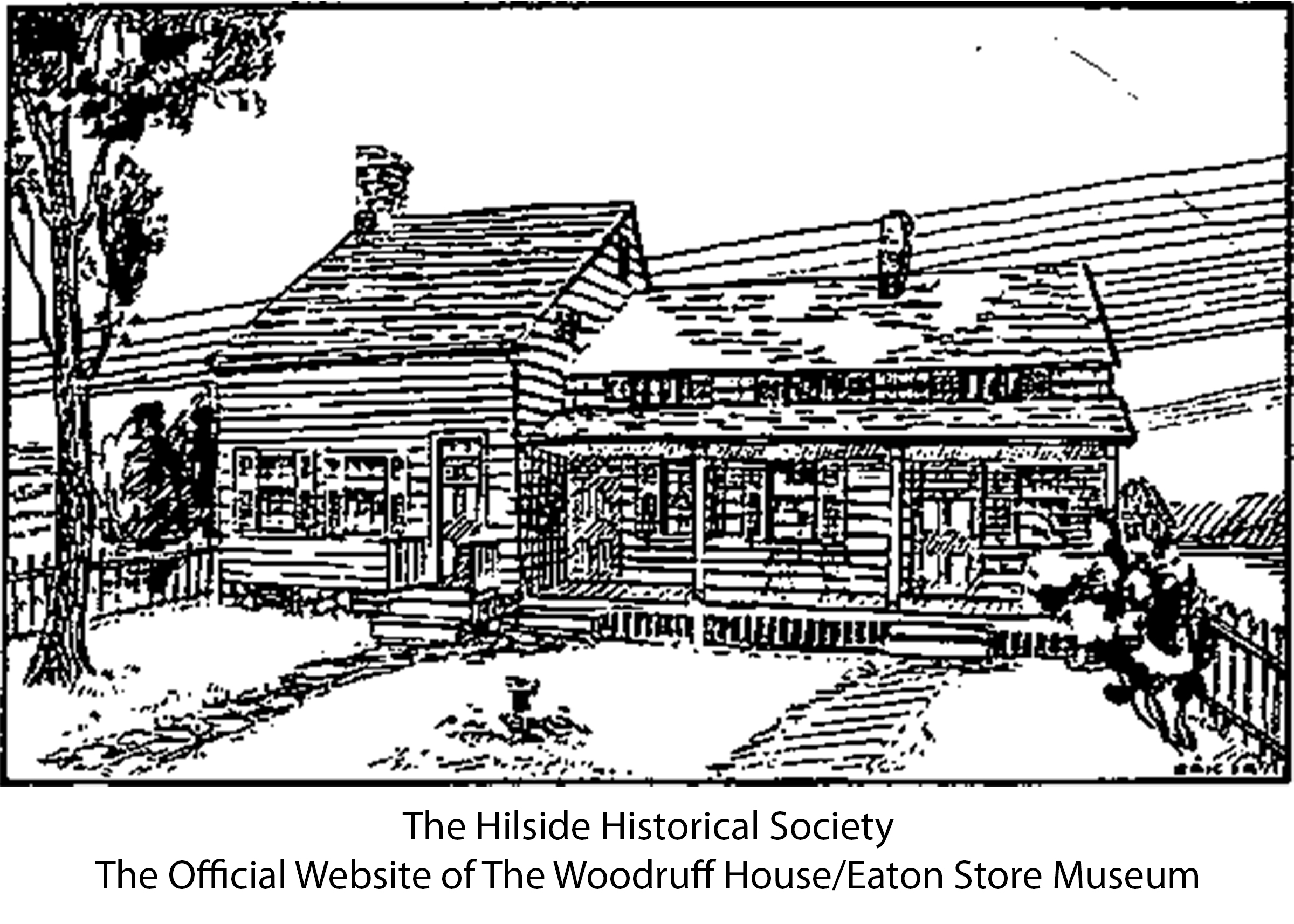The 1735 House
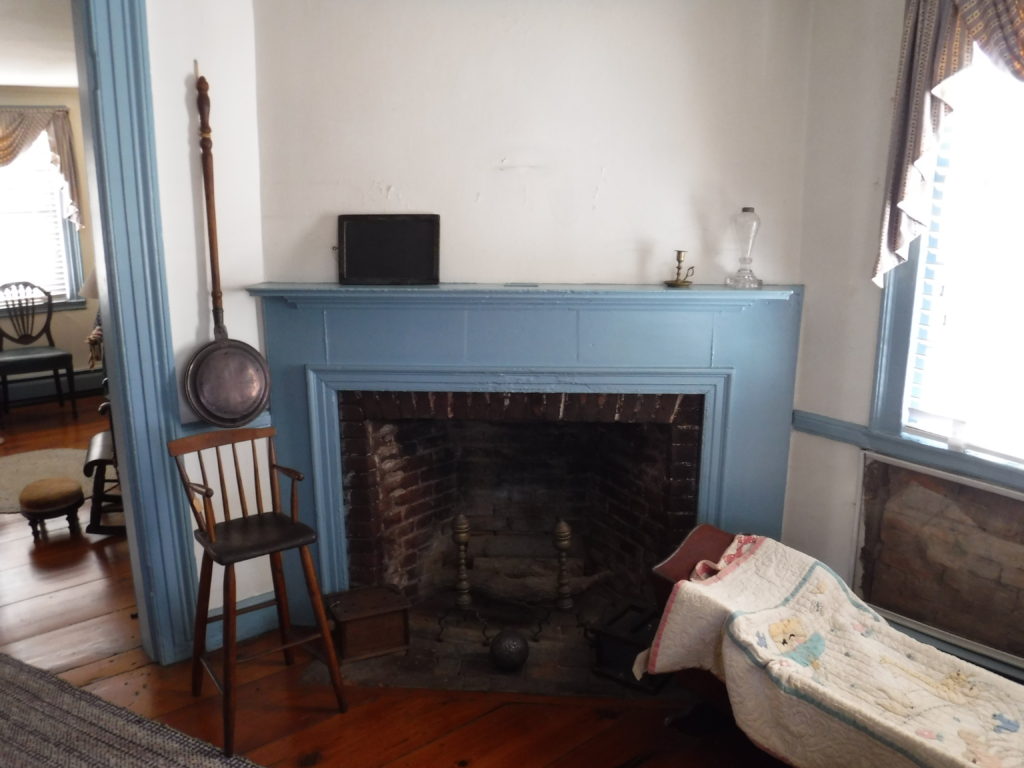
The 1735 section of the Woodruff house is the oldest portion of the house. Built around 1735 when George Washington was a mere 3 years old. This section consists of two rooms – the front room and the rear room. Restored to its original condition some say this is the most attractive portion of the house.
The Front Room

The front room contains a fireplace, storage space built into the wall itself as well as many unique items.
Entering the front room you see the main fireplace and the built in wall storage. The society has acquired Emma Woodruff’s wedding bonnet (circa 1860) that is now stored in the cupboard. We have also acquired a soup tureen and pitcher that we have verified where once used in the house. Button hook baby shoes and other dishware round out the cupboard collection. On the mantel is a clock circa 1824.
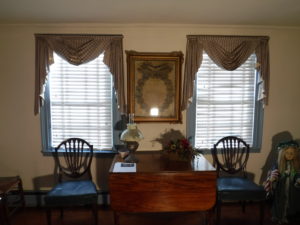
Turning left you are now looking out the front of the house. Framed between the two windows is a copy of the Declaration of Independence written on silk cloth in the early 1800’s. This item was donated by society member Marion Earl and comes from her estate. Marion Earl was a direct descendant of many of Elizabethtowns original settlers.

Looking in the corner you will see a portrait of Thomas Jefferson donated by Al Mading. In the display case are the Woodruff and Earl family bibles. They are opened to the birth and death records of the family which were recorded in the family bible. The woodruff family bible has dates going back to before the house was built. The table and chairs you see here where donated by Jane Eaton Schorr’s cousin Marian Kraft. Matt and Helen Witting drove to Florida to retrieve these items for the society.
Rear Room
The rear room also has a fireplace, although smaller and is currently setup as the “bedroom” of the historical house.
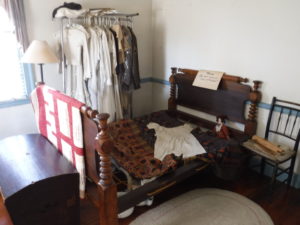
The main item in this room is the bed. The bed is rope strung. The “mattress” would have consisted of a stuffed straw, hay, or horse hair. Notice the chamber pot underneath the bed. Hanging in back of the bed is a collection of dresses and cloths the society has collected over the years.
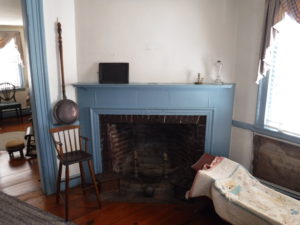
Although difficult to see in this picture, the window contains original glass from the house in 1735. Looking at it up close shows that it isn’t entirely clear and has “waves” which distort the view. This was normal for glass of that time. In addition the window consists of 6 panes over 9 panes. Glass panes where small because all glass was imported from England since there were no glass factories in the new world. Smaller glass had a much better chance of surviving the trip.
On the mantle to the left you’ll notice a slate. This slate belonged to Emma Woodruff. Marked on the wood frame is “1840 Salem School”. Salem school is now a home situated on a small hill just over the Salem Dam. This school was for all the children in the area. Children would carry the slate to school, do their work on it, and then carry it home for homework.
Hanging on the wall to the left of the slate is a cooper bed warmer.The device would have been filled with hot brick or coals and moved around between the mattress and comforter to warm the bed before going to sleep.

1790 Addition
1790- All Purpose Room
This section of the house was added around 1790. It contains a large cooking fireplace. The floors and ceiling are original to this section and were preserved through the years until they were uncovered during the restoration. The door you see in this picture now leads to a kitchen, but was originally part of the “borning room” where babies where born. This “borning room” was split to create two separate room, one now a bathroom and one a kitchen.
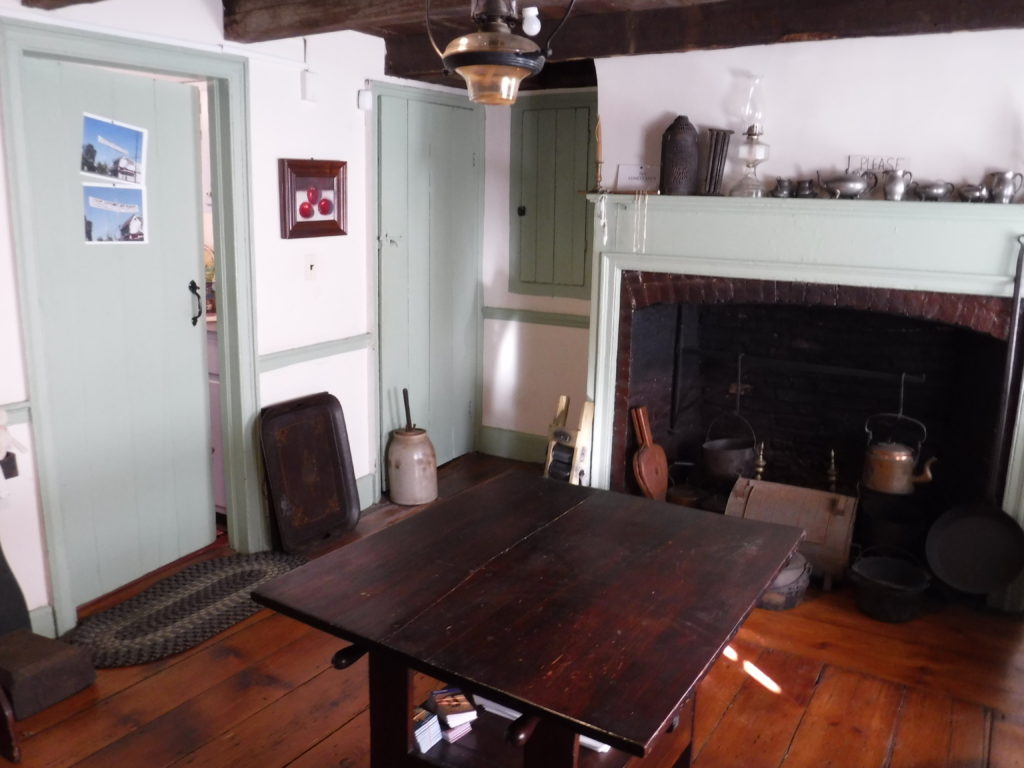
The Fireplace End
The fireplace was the focal point of the room and would have been used for cooking as well as heat.
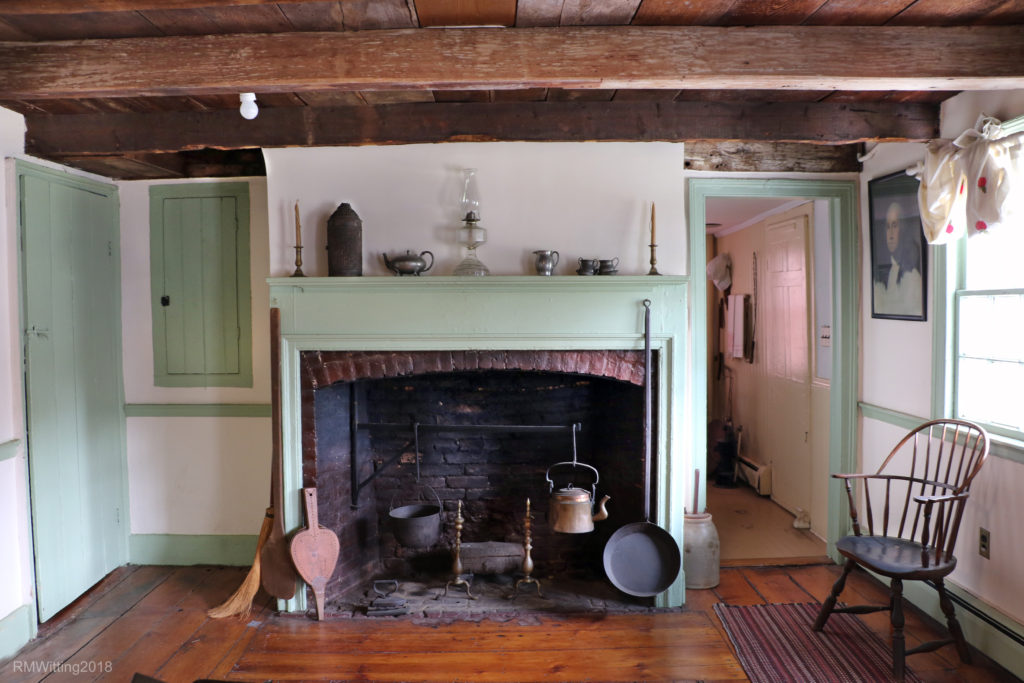
The large fireplace would have been the place where all the cooking was done. There is a large crane that was used to hold iron pots. This crane could be turned in and out of the hot fireplace to help with cooking. Although not visible in this picture, there are actual burn marks in the original floor where hot embers or coals burned holes into the floor. A collection of pewter items adore the mantel place.
Spinning Wheel End
The other side of the room contains many of the common tools that would have been found in this room in the 1790’s including spinning wheels and braiders.
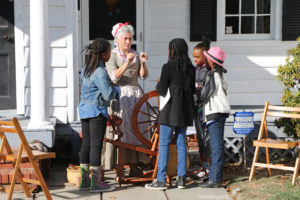

There is also a dry sink to the right in the picture above and a flour and sugar storage cabinet at the left of the picture. Different urbs would have hung from the ceiling to give the room a scent. Most of the furniture in this room is on loan from the Union County Historical Society.
1890’s Kitchen

Although this section of the house was part of the original 1790’s addition, it has be restored to resemble a typical 1890’s kitchen. Many of the items in this room would have exhibited in the original configuration of the house
The Kitchen
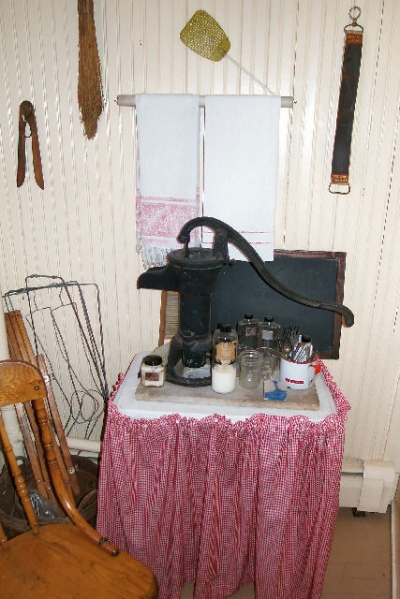
The well would have been located directly underneath this pump with a pipe extending into the well for the pump. There was probably a soapstone of other type of sink located here to collect any excess water.
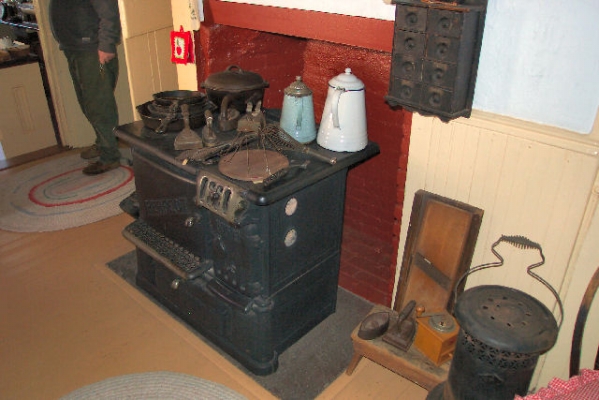
This smaller fireplace shares a chimney with the fireplace in the all-purpose room and would have probably been used in the summertime when starting a large fire wasn’t needed. A large coal stove now occupies the fireplace and would have been a vast improvement in cooking over the plain fireplace. Notice the many flat irons on the stove. People would have had more then on iron so that one could be heating while the other was used for ironing. Coffee pots and a stove top toaster are also present on the stove. A spice box is located on the wall.
The Eaton Store
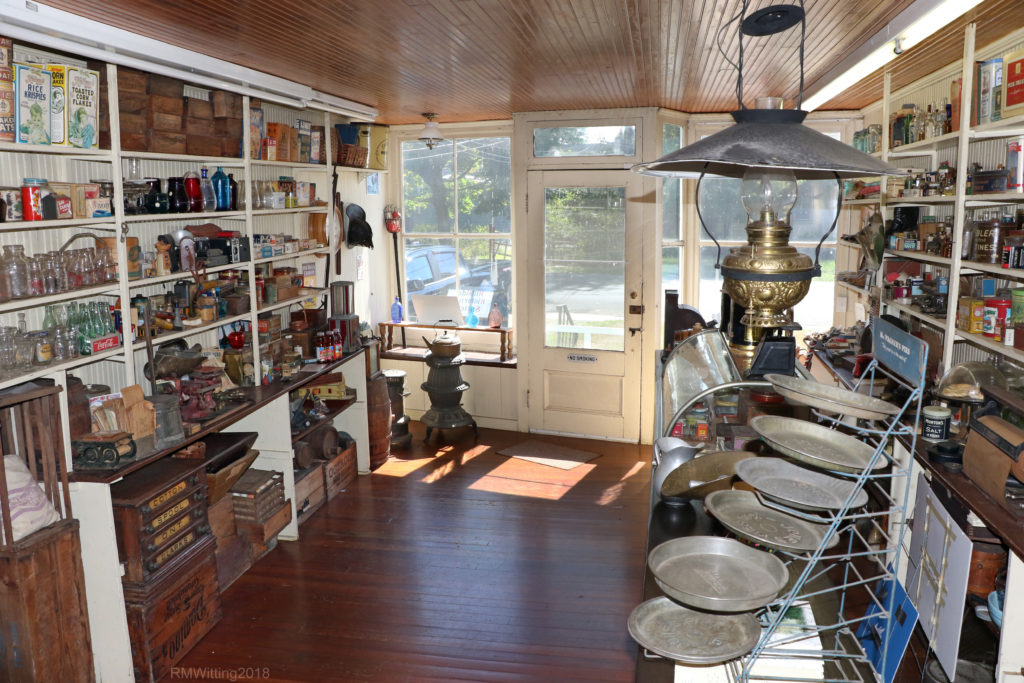
The store was added to the house in 1900 using the remaining lumber of the Woodruff’s new house next store. The store was intended to sell the apples, cider, eggs and other grocery items that the Woodruff’s produced. Although the last part added to the house, it was also in the worst shape when acquired by the society. It was the first part of the house restored and contains many original items from the store that were found in chicken coups in the back of the property.
History of the Eaton Store
What is now known as the Eaton store began almost by chance. In 1900 Charles T Woodruff and his wife Theresa Coyne Woodruff built a new house next store for their growing family. The home of parents and grandparents of Charles T. Woodruff which had been passed on from earlier generations was too small for them.
When the new house directly to the east was almost completed, it was apparent that sufficient lumber remained for other uses. Mrs. Woodruff had a sudden thought – why not build a little store on the front of the old house? SHe could use the store as a center for the sale of some of the Woodruff family orchards products – apples, peaches, along with eggs laid by the chickens which the family had in the back of the property.
Mrs. Woodruff was an active women – in her church and in a few sidelines such as newspaper reporting of “local items” in addition to her household duties and responsibilities. Her husband was in an increasingly active role in public life, including agitation for creation of a separate community apart from the township of Union (Later he became president of the union County Board of Agriculture). After a couple of years, Mrs. Woodruff tired of being tied down to waiting for customers to come into the little store, so the family rented it out to one neighbor after another.
Finally, by 1910 Gilbert Easton, who had built up a good business vending fruits and vegetables from his horse and wagon, agreed to rent the store. The house itself was vacant at the time, so the Eaton Family moved into the house. Sarah Baxter Eaton operated the store most of the time while her husband continued to go house to house selling some of the products. They continued the business until 1927, through the efforts to create the township of Hillside in 1913 and through the World War I years. Theirs was one of the few telephones in the area and many a message was relayed by Gilbert Eaton as a special favor for customers and neighbors.
Today the store has a new life as a major center of attraction for visitors, old and young, who see the Eaton store as a striking example of the vast differences between a neighborhood store of the early part of the century and the supermarkets of today. Some of the older visitors now remember the days of their childhood when they came into a store and with eye wide open and mouths watering asked for several items displayed in the candy case on the long counter.
As one enters the store as restored, curtains are still seen in the windows at the front. Jane Eaton Schorr a vice president of the Hillside Historical Society, grew up in the house and store, and as project director for the restoration from 1978 until her death in 1988, said her mother always had curtains in the windows. Regularly the historical society trustees see to it that the curtains are washed and simple displays are shown in the window area.
The store, although the newest part of the Woodruff property acquired by the society in 1978, was in the worst condition including a leaking roof and decaying corner wall and floor, all of which had to be repaired before the store could be returned to its 1910-1927 appearance. Mrs Schorr donated hundreds of collectors items of old time store products typical of the period. Other friends have dug out old keepsakes and donated them to the displays of the site. One must look around quite a bit to find similar old time store displays. Some exhibits today are representative of the times, not necessarily of this store.
A few of the items in the store are original. The old counter was discovered folded up and stored in the garage in back, a breadbox which once stood on the porch of the store was found in the basement, along with the old coffee grinder. A gas lamps hangs overhead, now electrified.
The shelves in the store are original. On both sides of the store one will find a variety of products, chess boxes, and so on. Cracker and cookie cartons and tins and other examples of old time sales are seen. The pole used years ago to “grasp” packages to bring them down from a top shelf is still in use.
Here people see sacks of flour, sugar sacks, tins cans containing butter in bulk – from which customers used to scoop out their needs and bring them to the grocer at the counter for weighing, on a very old type scale with weights to determine equivalent amounts. Here the old time grocers such as Mrs Eaton would take paper off a roll to wrap the purchases before typing in bother dictions and placing a handle on the cord for the customer to carry. A very old time cash register is at the end of the counter, able to at least record the figures involved without any register tape.
Near one corner of the store is a pot bellied stove, similar to the type which provided hear in the store many years ago. Its is one of the many reminder of the changes in life during the century. Including the lamp which hangs overhead.
Near the front of the store today stands a ballot box – not original t the store or of Hillside, but indicative of another change. Ballots with the old ballot box show the names of Woodrow Wilson and Vivian M Lewis, candidates for Governor in the election of 1919. (The box even contain unopened, uncounted ballots) Also here is the Williams Bread Box which at one time was out on the porch. According to a recollection of Gilberta Earon Scannell , spell binders stood on the top of the box to shout their demands for local representation for people in the area instead of government from far away Union Township! WHen they weren’t arguing out in front of the store, local townspeople might have been playing checkers on a barrel in the rear near the hear of the pot bellied stove.
In other words, the Eaton store was one of the several little community centers where people argued their points about secession from Union and where the boundary lines should be if ever independence could be won – which did arrive with a vote on April 29, 1913 in the single voting district that comprised what is now Hillside.
Virtual Tour
As stated in the history above, the society was lucky enough to have a member – Jane Eaton Schorr – who actually lived in the house and whose family had run the store for many years. This enabled us to accurately place original items and recreate the store as it was when her family ran it. After her death, the society honored her by naming the store the Eaton Store museum.


Looking in from the 1890’s kitchen you can get a good overview of the store. There is a step down into the store since the store has no basement as does the rest of the house. From this vantage point you can see several of the original items from the store including the gas lamp hanging above, the counter, the candy case, and the Williams Bread Box in the back left.

Stepping down and looking back you can see one of the unique features of the store. During the restoration the society discovered the original clapboard from the 1790’s house behind the back wall. The society decided to leave a “window” of it open to show how the store was added. This is also the corner where the pot-bellied stove would have been.

Looking to the left and behind the counter you see the original coffee grinder from the store. Restored to its original condition the coffee grinder still works to this day. The grinder was located in this exact position when the store was open.

A close up of the refurbished lamp and candy case – both original to the store.
The Barn

An Authentic Post & Beam Barn
The Hillside Historical Society conducted an old fashioned Barn Raising in 1989. The Barn was built to replace several original Woodruff family barns that were lost to fire. This barn was built in the classic barn building style of the period using no nails whatsoever in the frame of the barn. The entire frame is built using mortise-and-tenon joints that are held together by wooden pegs.
The Agricultural Museum at “The Barn”
Seen at different locations in the barn are various tools for every-day use on a farm.
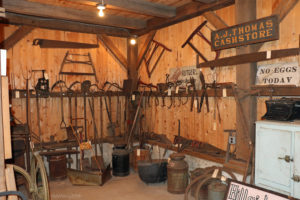
There are some sickles, used to cut down grass and weeds. There are also a combination scythe-and-rake used to harvest hay. Although the blade is now missing on this tool it would have been fastened near the last finger of the rake so that the hay would be cut and gathered with each swing.
Cutting tools must be kept sharp to do the best work. near the wall is the grindstone, a large round light colored wheel on a stand. It can be operated by foot treadle, or it can be turned by a crank handle on the other side. The wheel is abrasive or gritty and when rotating will sharpen knives and other tools held against it. A hooked rod sticks up over the wheel upon which a small container of water should hang. A small spigot on the can allows a few drops of water to drop constantly onto the work to keep it cool. Otherwise the friction of the wheel might overheat the work and burn it.
The barn contains many buck saws. They are used to cut firewood from logs resting in a saw-buck, which is an “X” shaped stand made of wood. Used with two hands, a sharp saw can easily cut logs of eight or ten inches in diameter to fireplace length. The wood can then be split with an ax.
Also on exhibit are shoemaker lasts, needed for repair of boots and shoes.
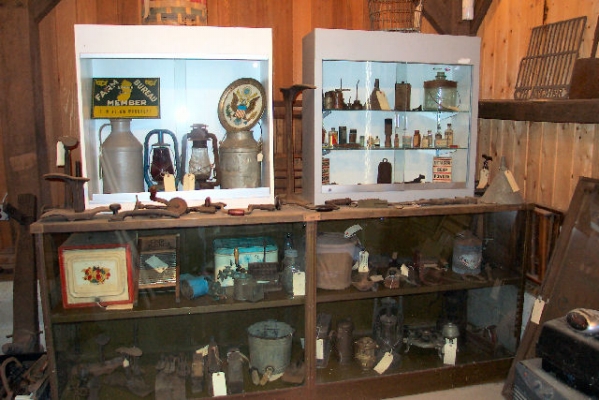
Slipping a worn shoe over the foot-shaped support would allow a shoemaker to nail new heels or soles on the old shoes.
The barn’s main purpose was to house the horses that where used for much of the heavy labor around the woodruff property. The barn has two lofts that would have stored hay for the horses for the winter months. Today the society keeps some of our collection such as baby carriages up in the loft out of harms way.
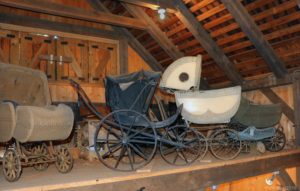
A view of the other loft.


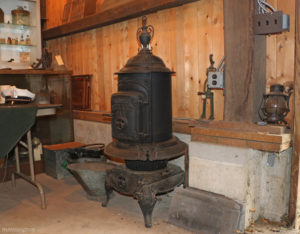
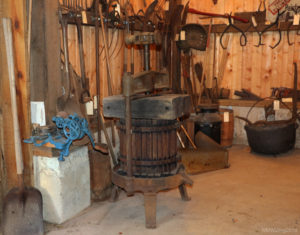
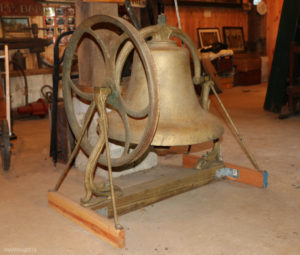
Farm Equipment
The society was luckily enough to have an complete set of farm equipment donated to it. It is displayed outside the barn. Among the items on display are two horse drawn manure spreader, a seed planter, and a device to smooth our furrows left by a moldboard of a plow.



Phil Rizzuto/Sports Museum

Phil Rizzuto – Hillside’s Hall of Famer
For those who have lived in Hillside, Phil Rizzuto was always a home town hero. And the entire town celebrated in 1994 when Hillside’s own Phil Rizzuto was elected to the Baseball Hall of Fame. To honor him and all other Hillside athletes the society established the Phil Rizzuto and All Sports Museum.
Phil Rizzuto
Entering you see two large display cases in front of you although with a display housing various newspaper clippings.
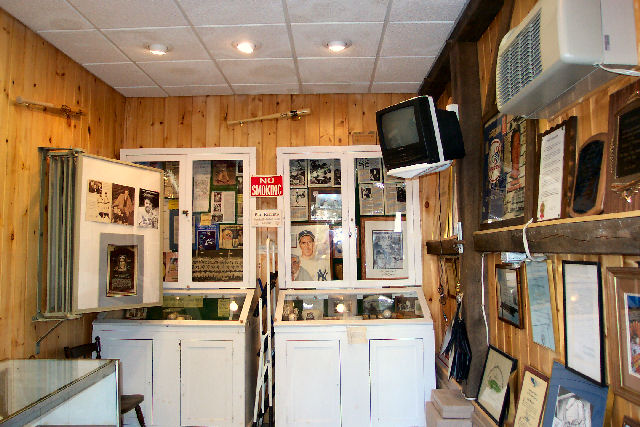
Along the right hand wall are various plagues and honors donated by Phil Rizzuto.
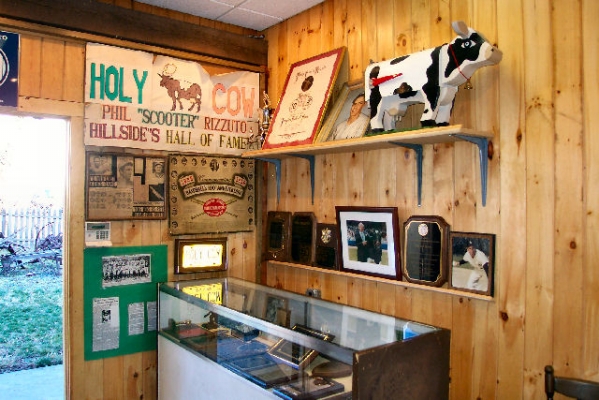
Turning around you see some of the “holy cow” memorabilia. Among these are the holy cow mailbox and the original holy cow banner that accompanied the Hillside buses up to Cooperstown for the Hall of Fame ceremony.
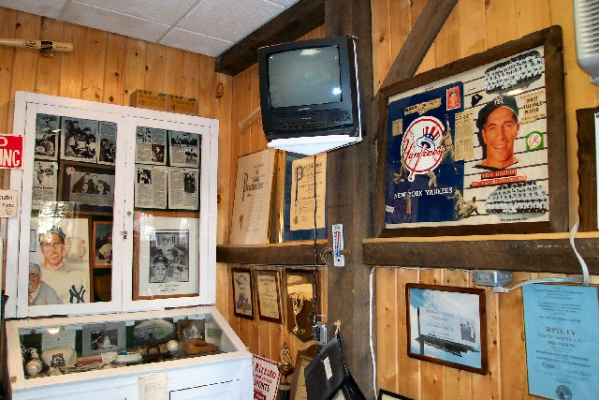
A small television plays videos of Phil Rizzuto’s induction into the Hall of Fame along with a larger documentary of his visit there on the days leading up to his induction.
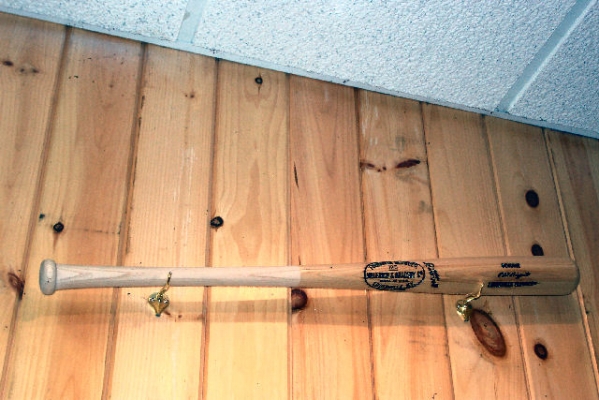
An authentic “Phil Rizutto Louisville Slugger”
The Outhouse

This replica Outhouse/Privy was built in 2006 to serve as an example of a period outhouse. Like all homes of the time, the woodruff house would have had an outhouse on the property. The original outhouse would not have been this “fancy” and would have been located farther away from the house then the replica is.
The Outhouse as built is a “two seater” having seats for both adults and children. Our replica is, of course, non functional.
Stone walkways lead visitors to the outhouse from both the back of the 1735 section as well as from the driveway right behind the archives.
Inside the Outhouse
This outhouse was designed as a “two seater” with one seat for an adult and one for a child.

Between the two seats is a replica of a 1910 Sear Catalog. In the past Sears Catalogs were often used not only as handy reading material but as toliet paper.
